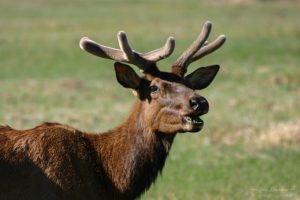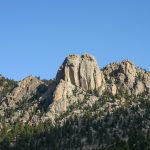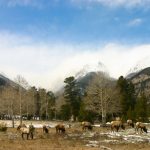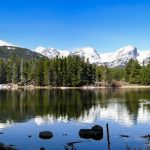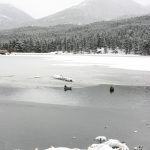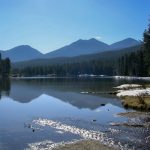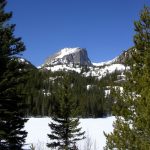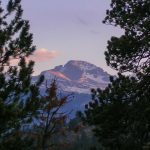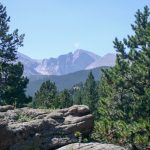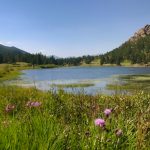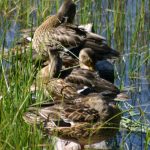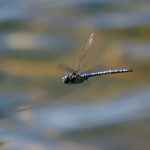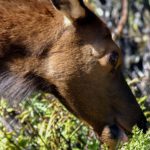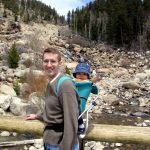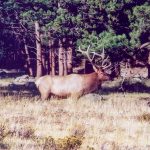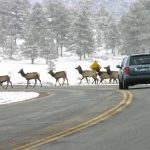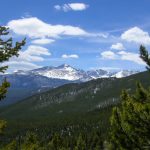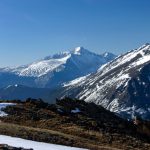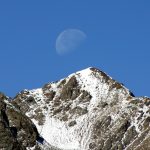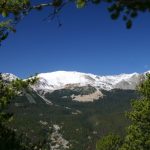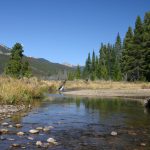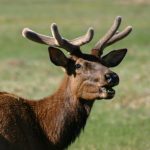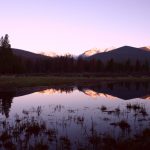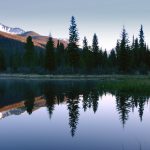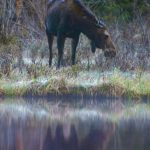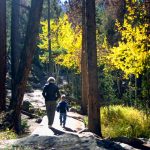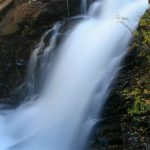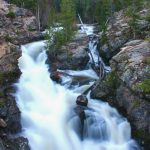 Declared a National Park in 1915, Rocky Mountain National Park, Colorado, is home to hundreds of peaks more than 10,000 feet tall including the 14,255 ft Longs Peak, one of Colorado’s tallest. More than that, the boundaries of Rocky Mountain NP encompass an entire set of mountain ecosystems and the wildlife which make them unique.
Declared a National Park in 1915, Rocky Mountain National Park, Colorado, is home to hundreds of peaks more than 10,000 feet tall including the 14,255 ft Longs Peak, one of Colorado’s tallest. More than that, the boundaries of Rocky Mountain NP encompass an entire set of mountain ecosystems and the wildlife which make them unique.
Visitor Rating (write your own review below)
So beautiful and accessible!
Wildlife![]()
ILNP Park Review
In a Word. “Invigorating”
“You will go out in joy and be led forth in peace; the mountains and hills will burst into song before you, and all the trees of the field will clap their hands” -Isaiah 55:12
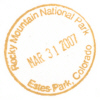 Our Visits. We live in Colorado, so Rocky Mountain National Park is kind of our “Home Park.” My first trip to the park was as a college student when my family visited in September 1993. Other trips occurred in June of 1997, September 2000, April 2005, March 2007, August 2007, October 2007 and May 2009.
Our Visits. We live in Colorado, so Rocky Mountain National Park is kind of our “Home Park.” My first trip to the park was as a college student when my family visited in September 1993. Other trips occurred in June of 1997, September 2000, April 2005, March 2007, August 2007, October 2007 and May 2009.
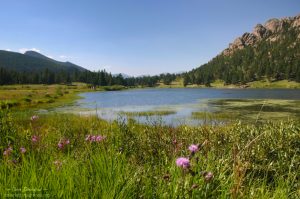
Flowers on the banks of Lily Lake with the Continental Divide just barely visible in the background (August)
The first trip with my family was spent hiking around the Alluvial Fan area. The second trip was primarily a driving trip across the mountain range with only a little hiking. The third trip was spent searching for elk herds in the fall when the bulls were bugling–this took us to most of the meadows on the East side of the park. The fourth and fifth trips were in early Spring when most of the trails were still snow-covered, but we found some open spots on the road to Bear Lake. The sixth trip was part of a scenic drive along the eastern side of the park, so we only stopped in the small Lily Lake area along Colorado Hwy 7. The seventh trip was an excursion through the west side of the park the first week of October. The latest trip was a half-day trip to the west side from a vacation spot in Winter Park, CO in late May.
Our Weather. Because we live relatively close, we could schedule our trips around good weather. Consequently, we had beautiful sun and pleasantly warm temperatures. However, remember that nearby Denver, Colorado has the most sunny days of any major city in the U.S., so your chance of finding good weather in Rocky Mountain is good. If you visit October – June, plan to be surprised by a snowstorm.
Overall Impression. Rocky Mountain National Park may not be the most spectacular Park, but it holds a charm and native beauty that make it a special place. There are so many diverse areas to hike in this Park that’s it’s difficult to know where to start. Even a trip by car with no hiking takes you from sprawling meadows, alpine lakes, wildflowers and pine forests to tundra and thick snow above the tree line. For those willing to spend some energy on one of the trails, Rocky Mountain really shows off her hidden treasures, especially the many species of wildlife which call this area home.
Favorite Spot. the reflections in Sprague Lake

Looking south down the continental divide from Trail Ridge Road (US 34), the main road through the Park (May)
Minimum Time Required. You can drive through the park via Trail Ridge Road (US 34) in about 2-3 hours during the summer months (road closed Fall through Spring). This will allow you to take in the beautiful mountain scenery, see a few animals in the meadows and stop for a few photos. If you’re not up for a full drive through the Park, you can get a small taste for it by stopping and hiking one of the trails on the parks periphery. On the east side, look for Lily Lake. This area, complete with a visitors center, is easily accessible from Colorado Hwy 7 and does not have an entrance fee. In about 30 minutes you (and your entire family) can hike around the lake and enjoy wildflowers, wildlife and views of 14,000 ft Longs Peak. On the west side, you can drive through the quaint town of Grand Lake and take the easy hike (.6 miles round trip) to Adams Falls then visit the Kawuneeche Visitors Center for displays and information. Trail Ridge Road requires the full entrance fee, but the last two activities can be done fee free.
A Longer Visit. We’d recommend spending at least a full day in the park so you can drive Trail Ridge Road (US 34) across the continental divide (summer only) and take a few short hikes or one longer one. If you’re on the east side of the park (Estes Park), split your time between Trail Ridge Road and the Bear Lake area. The road to Bear Lake has great scenery and some great hikes of all lengths. One of the best short hikes is Sprague Lake where you can see reflections of Hallett Peak and the continental divide on a calm day. Another great area on the east side is Alluvial Fan off Old Fall River Road where you can hike to the sounds of the nearby waterfalls and Sheep Lakes where you can usually spot wildlife. If you’ve got time, drive up and over the continental divide on Trail Ridge Road and stop at the Alpine Visitors Center at nearly 12,000 feet to enjoy a warm beverage above the tree line.
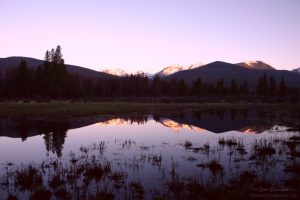
Looking west at sunrise, the tips of the peaks have just been illuminated by the rising sun. This is taken from an unnamed pool adjacent to the Colorado River in the Kawuneeche Valley (May)
If you’re on the west side (Grand Lake), enjoy the atmosphere of fewer people and cooler air. Start with a visit to the Kawuneeche Visitor Center. There is less variety for hiking on this side of the park, but you can take a short excursion on one of the longer trails in the Colorado River Valley to get a closer look at flowing streams, meadows and wildlife. The trail to the Holzwarth Historic Site is prime for viewing elk, but skip the historic site unless you’re into 1920s-era fishing lodges. The Beaver Ponds picnic area is great for reflecting the Never Summer Mountains on a calm day. Once you’ve gotten your fill of the valley, drive up the switchbacks on Trail Ridge Road for some good panoramic views and a look at things above the tree line. Even as late as June and as early as September, this road may be lined with several feet of snow, and the road is normally only completely open in the summer. On your way to the Alpine Visitors Center, you’ll pass vistas of the distant Gore Range and Medicine Bow Mountains, so make use of the pullouts for some great views. If you’re not planning on driving all the way through the park, head east at least a few more miles to cross the continental divide and to get a view of the peaks on the
Suggestions. Rocky Mountain, while a beautiful park, doesn’t have quite the awe-inspiring sights of Zion or Yosemite. The park’s real value is the preservation of an entire alpine habitat from the forests all the way to the snowy peaks, so to really appreciate Rocky Mountain, you have to spend a little time in each of the climate zones. The best way to visit all the climates is to drive all the way through the park on Trail Ridge Road (US 34) as part of your trip.
If your goal is to view wildlife, your best bet is to go around sunrise or sunset and visit one of the “parks” on the east side or the Kawuneeche Valley on the west side. Elk are plentiful throughout the day, but they are typically closer in the morning or evening. The moose are more shy than the elk, but you can still see them near the wetlands of the Colorado River on the west side of the park (they’re only on the west side of the park). We would recommend early morning for viewing (6 AM in the summer) because there aren’t many people in the park, and you’ll be alone with the wildlife. If you can pick your time of year, late September is a great time because the elk are in rut. From just about any meadow (called “parks” here), you can see (and hear) bull elk bugling. This is most common in the evening. Additionally, the aspens turn a brilliant gold and hold it until early October. September is also the last full month Trail Ridge Road is open through the park.
If you’re travelling through the area in the winter or spring, just beware US 34, the only road through the Park, is closed from at least mid-October ’til June. You can still hike in the lower areas, you just won’t be able to see everything. If you only have a limited time in the Spring, take the road to frozen Bear Lake for great views of distinctive Hallett Peak. Stop at the lower (read “unfrozen”) Sprague Lake along the way for a pleasant 1/2 mile hike. If you are going to stop and walk around the peaks, bring a warm jacket. The temperature at elevation can easily be 20-30 degrees cooler than the entrance, even in the summer. Also, if you’re from out-of-town and not used to the elevation, DRINK LOTS OF WATER!!! This will help keep you from getting dehydrated (and getting headaches) in the high, dry climate. If you’re fair skinned, remember your sunscreen, because the elevation causes you to burn about twice as fast as lower elevations.
Nearby Towns Estes Park, Grand Lake, Granby, Loveland, Denver (Colorado)
Other Nearby Attractions Winter Park ski area, Lake Granby, Estes Park
Official NPS Website Rocky Mountain NP
- This formation, known as the “Twin Owls” is a familiar landmark for residents of Estes Park, CO. It sits just inside Rocky Mountain National Park. To illustrate how fickle Colorado weather can be, this picture was taken just two days after the one of the elk in the snow (March)
- Elk herd in Rocky Mountain NP, (March) (Dean Edwards Photo)
- The Moraine Park area is a great place to view elk and catch some nice scenery, even in the winter (March)
- Reflections of Hallett Peak in Sprague Lake (April)
- Sprague Lake on a snowy day in March. Compare to the photo on the right taken on a warmer day
- Reflections in Sprague Lake (April)
- Hallett Peak atop a frozen Bear Lake in April
- Longs Peak at sunset from the Beaver Meadows Visitors Center (April)
- This view of Longs Peak is from just outside the Park on Colorado Hwy 7 just north of the turnoff for the Longs Peak trail area (August)
- Flowers on the banks of Lily Lake with the Continental Divide just barely visible in the background (August)
- This brilliantly colored thistle near Lily Lake is among hundreds of species of flowers in Rocky Mountain (August)
- Ducks preening on Lily Lake (August)
- A huge, bright blue dragonfly checking out a plant on the banks of Lily Lake (August)
- While there are many warnings around the park telling you not to approach the wildlife, sometimes they approach you. This cow elk was grazing right next to the road on the west side of the park, and this picture was taken from the car window (October)
- Me and my son at the base of the Alluvial Fan (April)
- Colorado in September is wonderful. Besides the changing aspens, the bull elk in Rocky Mountain are bugling (September)
- Beautiful elk buck awaiting its next bugle (September)
- Elk rule the park, and the elk crossing signs are not something to be ignored (March)
- Longs Peak from Many Parks Curve (April)
- Looking south down the continental divide from Trail Ridge Road (US 34), the main road through the Park (May)
- The moon makes a nice backdrop for this view of the Never Summer Mountains from Farview Curve (October)
- The Never Summer Mountains frame the west side of the park, and true to their name, they are covered in snow the forst day of October
- Fall is a beautiful time of year with Aspens chaging to gold and sometimes orange in September and early October (October)
- The Kawuneeche Valley runs north-south along the western edge of the park. There are many places to stop and walk through the meadows. This is near the Bowen/Baker trailhead (October)
- A bull elk in velvet near the Holzwarth Historic Site in the Kawuneeche Valley (May)
- Looking west at sunrise, the tips of the peaks have just been illuminated by the rising sun. This is taken from an unnamed pool adjacent to the Colorado River in the Kawuneeche Valley (May)
- Rocky Mountain NP is a magical place at sunrise; not only are the animals out in great numbers, but the lakes and ponds make for beautiful reflections. This is the area known as the “Beaver Ponds,” (May)
- Moose live in the western half of the park, but you have to catch them near sunrise or sunset. This moose is grazing at the Beaver Ponds at sunrise (May)
- The hike to Adams Falls in the southwest corner of the park is easy and colorful (October)
- Adams Falls is a neat arrangement of small falls just east of Grand Lake. This is one of the small falls visible from the generous viewing area (October)
- Another shot of Adams Falls, this one taken just before sunrise (May)
Write Your Own Review


